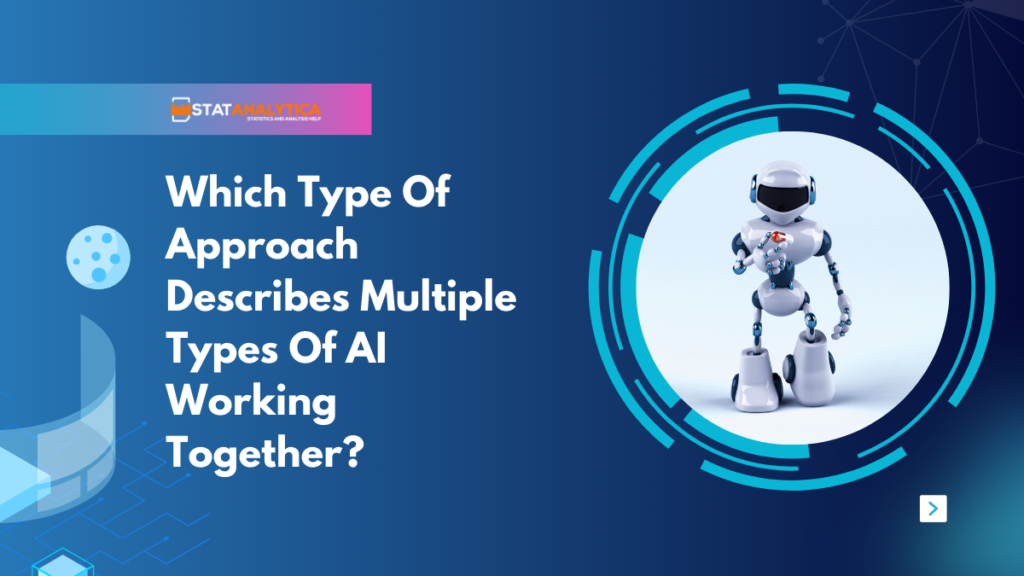Artificial Intelligence (AI) is like a superhero team with different powers. Each type of AI has its unique abilities, and when they work together, they can achieve amazing things. But have you ever wondered which type of approach describes multiple types of AI working together? Let’s dive into the fascinating world of AI teamwork!

What Are The AI Types?
Table of Contents
- Narrow AI
- Think of Narrow AI as a specialist. It’s really good at one specific task, like playing chess or recognizing faces.
- Example: Siri or Google Assistant can understand and respond to voice commands, but they can’t write poetry or play the guitar.
- General AI
- This type of AI is like a generalist. It can learn and understand things across different domains, just like humans.
- Example: IBM’s Watson, which can answer questions across various topics and even beat human champions in games like Jeopardy!
- Machine Learning (ML)
- ML is a type of AI that learns from data. It can recognize patterns and make decisions without being explicitly programmed.
- Example: Netflix uses ML to recommend movies based on your watching history.
- Deep Learning
- Deep Learning is a subset of ML that mimics how the human brain works, with interconnected layers of neurons.
- Example: DeepMind’s AlphaGo, which defeated the world champion in the game of Go by learning from millions of game positions.
The Collaboration: How AI Works Together In Reality?
Now, imagine combining these different types of AI to solve complex problems. It’s like assembling a dream team where each member brings their unique strengths to the table.
Medical Diagnosis
Doctors can use Narrow AI to analyze medical images like X-rays and MRIs, while ML algorithms can sift through vast amounts of patient data to identify patterns. General AI can then interpret the findings and provide recommendations for treatment.
Autonomous Vehicles
Self-driving cars rely on a combination of Narrow AI for specific tasks
Virtual Assistants
When you interact with virtual assistants like Alexa or Siri, they use a mix of Narrow AI for speech recognition, ML for understanding context, and General AI for executing tasks and providing responses.
Which Type Of Approach Describes Multiple Types Of AI Working Together?
The approach that describes multiple types of AI working together is known as interdisciplinary or integrated AI. Here are some points with relevant examples:
Interdisciplinary AI Approach
- This approach combines the strengths of various AI types to tackle complex tasks.
- Example: In autonomous vehicles, Narrow AI is used for specific tasks like image recognition, ML for learning driving patterns, and Deep Learning for real-time decision-making.
Synergy of Different AI Types
- By leveraging the capabilities of Narrow AI, ML, and Deep Learning, interdisciplinary AI achieves greater efficiency and effectiveness.
- Example: Virtual assistants like Siri or Alexa utilize Narrow AI for speech recognition, ML for understanding context, and General AI for executing tasks.
Optimizing Problem-Solving
- Integrated AI optimizes problem-solving by utilizing the right AI type for each aspect of the task.
- Example: In medical diagnosis, Narrow AI analyzes medical images, ML sifts through patient data, and General AI interprets findings and provides recommendations.
Complex Challenges Addressed
- Interdisciplinary AI is adept at addressing complex challenges that require a combination of specialized skills.
- Example: IBM’s Watson combines Narrow AI for processing medical literature, ML for learning medical concepts, and General AI for answering medical queries comprehensively.
Innovation and Advancement
- This approach drives innovation and advancement by harnessing the collective intelligence of different AI types.
- Example: DeepMind’s AlphaGo utilized Deep Learning to master the game of Go, showcasing the power of interdisciplinary AI in achieving groundbreaking feats.
What Are The Two Approaches Used For Modelling AI Systems?
Two common approaches used for modeling AI systems are:
- Symbolic AI (or Rule-based AI)
- Symbolic AI involves programming explicit rules and representations of knowledge to enable reasoning and decision-making.
- This approach relies on symbolic manipulation of data and logic to simulate human-like intelligence.
- Examples include expert systems, where domain-specific knowledge is encoded in rules to provide expert-level advice or decision-making.
- Symbolic AI is often used in applications where transparency and interpretability are crucial, such as medical diagnosis or legal reasoning.
- Connectionist AI (or Neural Network-based AI)
- Connectionist AI, which is like the brain, learns from examples to recognize patterns and make predictions.
- It uses artificial neural networks made of connected nodes, or neurons, arranged in layers. Each layer helps process and change the data.
- Examples include deep learning models used in image recognition, natural language processing, and speech recognition.
- Connectionist AI excels at tasks involving pattern recognition, classification, and complex data processing, often achieving human or superhuman performance levels.
Each method has its pros and cons, and which one you pick depends on what you need your AI system to do and how it needs to work.
Symbolic AI tends to be more transparent and interpretable but may struggle with handling large amounts of unstructured data.
On the other hand, Connectionist AI is highly effective at learning from vast datasets and performing complex tasks, but it can be challenging to interpret and understand how decisions are made.
Challenges and Opportunities With Multiple Types Of AI
While the synergy of multiple AI types opens up exciting possibilities, it also presents challenges.
- Data Compatibility: Different AI systems may require data in different formats, making integration complex. Standardizing data formats and protocols can help overcome this hurdle.
- Interpretability: Deep Learning models, in particular, can be black boxes, making it hard to understand how they arrive at decisions. Developing methods for explaining AI reasoning is crucial, especially in critical applications like healthcare and finance.
- Ethical Considerations: As AI becomes more pervasive, it’s essential to ensure that it benefits society and doesn’t reinforce biases or infringe on privacy rights. Ethical guidelines and regulations are needed to govern AI development and deployment.
Conclusion
Which type of approach describes multiple types of AI working together? The future of AI lies in collaboration. By combining the strengths of different AI types, we can tackle complex challenges and create innovative solutions that benefit humanity.
As we continue to explore the possibilities of AI teamwork, let’s also remain mindful of the ethical implications and strive to build a future where AI serves as a force for good.


